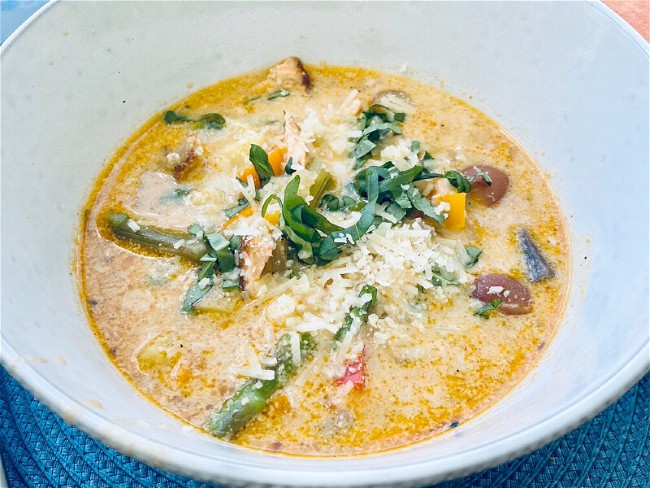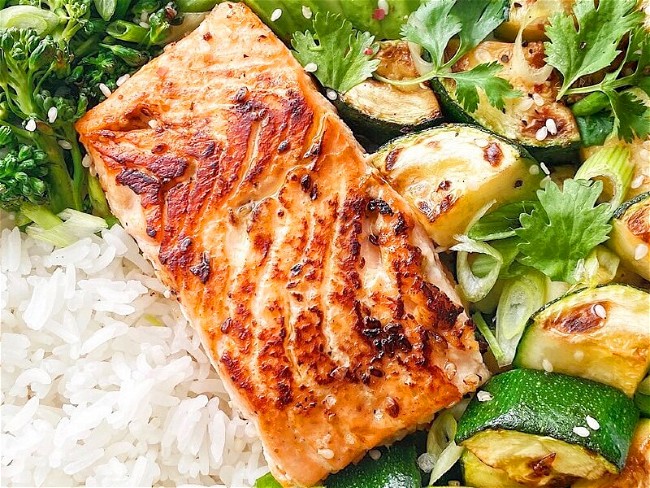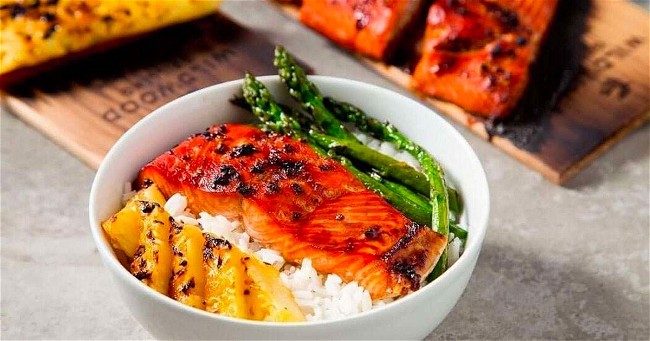Your Essential Guide To Salmon

Salmon is one of the most commonly consumed fish worldwide. Its rich, fatty texture makes it a versatile ingredient that can be prepared in endless ways. Various salmon species can be found on menus across cuisines from soul food to sushi, ceviche to croquettes. It takes well to endless preparations like grilling, pan searing, roasting, poaching, broiling, and smoking.
- Salmon History
- What Does Salmon Taste Like?
- How Do Salmon Get Their Color?
- What Are The Different Types of Salmon?
- Is Wild-Caught or Farmed Salmon Better?
- Is Salmon Sustainable?
- Is Salmon Good For You?
- What Are Copper River Salmon?
- Salmon vs. Trout: Key Differences
- Is Steelhead a Salmon?
- Can You Eat Salmon Skin?
- Our Favorite Salmon Recipes
Salmon History
While salmon has long been an important food source for coastal communities, it surged into mainstream popularity in the 1980s, starting with the development of Chile’s large-scale Atlantic salmon farming industry. Ideal conditions for aquaculture (seafood farming) and government subsidies enabled Chilean Atlantic salmon to flood global markets at low prices, making salmon an affordable year-round protein source for US consumers.
Around the same time, Norway made a push to introduce their own salmon into the more challenging Asian markets. Norway launched a marketing campaign to sell its salmon to Japan, whose people were not fond of raw salmon sushi because of the parasites in locally wild-caught salmon. The Norwegian campaign promoted their farmed salmon as a safe and delicious alternative to Japanese salmon. As a result, salmon is one of the most popular sushi ingredients in Japan and the world.
Today, salmon remains a coveted protein, but consumer confusion persists around topics like differences between species, sustainability issues, and wild versus farmed options. We will use our over 200 years as seafood experts to answer everything there is to know about salmon, from its many species to its flavor profiles, common prep methods, and health benefits.
What Does Salmon Taste Like?
Salmon is generally described as rich and buttery with slightly sweet undertones. When cooked, the texture becomes smooth and moist with large meaty flakes, while raw salmon has a more velvety, melt-in-your-mouth texture. Variations between species, environment, diet, fat content, harvesting, and handling methods all contribute to a salmon’s nuanced flavors. Overall, salmon is valued for its versatility in pairing with many flavors and preparation methods.
How Do Salmon Get Their Color?
Salmon get their characteristic pink to red-orange hues from their diets, which contain natural pigments called astaxanthin. Astaxanthin is vital for a salmon’s health, supporting its metabolic, muscle, and immune functions. Wild salmon eat astaxanthin-rich shellfish and krill, while farmed salmon receive astaxanthin as a natural ingredient in their feed for optimal health and color. A genetic condition prevents about 6% of king salmon from processing these astaxanthin pigments, resulting in white or ivory-colored “ghost salmon.” These rare salmon are adored by some chefs for their unique appearance while retaining the same rich flavor as other king salmon.
What Are The Different Types of Salmon?
In total, there are eight species of salmon– one Atlantic salmon and seven Pacific salmon. Of these, two Pacific species (masu and amago) are native to Asia and cannot be found in North American waters. Here are the six different types of salmon you can find in North America, each with their own features and flavors that make them unique:
- Atlantic Salmon: The Atlantic salmon is the most common salmon species consumed around the world, accounting for over 90% of North America’s salmon consumption. Although some wild Atlantic salmon exist, most are farmed in Norway, Chile, Scotland, and Canada. Atlantic salmon average 6-12 pounds with a blue-green back and silver sides. They have delicate, buttery flesh that cooks up moist and flaky. Their high-fat content makes them well-suited to cooking methods like grilling, broiling, baking, and poaching. Atlantic salmon is also the most popular species for sushi due to its high-fat content, mild taste, and affordability.
- Chinook (King) Salmon: Also known as quinnat or blackmouth salmon, king salmon are the largest species in the family, sometimes exceeding 40 pounds. They have blue-gray metallic scales, black spots on their back and tail, and black mouths. King salmon are abundant in the Pacific Ocean from California to Alaska. King salmon have a firm yet rich flesh, ranging in color from ivory to deep red. With the highest fat content among Pacific salmon and a full flavor profile, king salmon are stellar for grilling, smoking, roasting, and baking. King salmon are also popular for raw preparations like sashimi. These prized fish can be found both wild-caught and farm-raised.
- Coho (Silver) Salmon: Also called silver salmon, coho salmon average 8-12 pounds and are identifiable by dark metallic blue scales and lighter silvery sides. These Pacific salmon are abundant on coasts from California to Alaska, with a small population in the Great Lakes. Coho salmon have bright orange-red flesh that cooks up firm, moist, and flavorful. Their moderate fat content and mild, nutty flavor make coho salmon perfect for pan-searing, grilling, poaching, and smoking. Traditionally a wild species, some coho are now farm-raised as well.
- Keta (Chum) Salmon: Sometimes called dog or calico salmon, keta salmon are Pacific salmon that average 7-18 pounds and are identified by spotted patches on their backs and tails, as well as their large eyes. They have lighter flesh ranging from pale pink to orange. Keta salmon have a lower oil content than other salmon, resulting in a mild and delicate flavor. Often canned or smoked, keta salmon works well in burger patties, soups, chowders, and fish sticks. Keta salmon are notorious for their eggs, known as ikura, a delicacy in sushi and other cuisines. Keta salmon are exclusively wild fish migrating along the Pacific coast and inland waterways.
- Pink (Humpy) Salmon: The smallest salmon species at just 3-5 pounds, pink salmon have a pronounced hump on their back when spawning. Their skin has various pink, green, and silver tones, with large black spots on their backs. Pink salmon’s flesh color varies from white to deep red. Like keta salmon, pink salmon are often canned or smoked. Fresh pink salmon has a delicate flavor and tender texture suitable for smoking, grilling, and baking. Pink salmon are wild fish primarily caught in Alaska and the Pacific Northwest. Like the ikura of keta salmon, pink salmon roe is a treat in many cuisines.
- Sockeye (Red) Salmon: Sockeye salmon earn their name from their bright red-orange flesh, which comes from their krill-rich diet. They average 4-15 pounds and reach an intense scarlet hue when migrating upstream to spawn. Aside from their vibrant flesh, you can also identify sockeye salmon by their gold-colored eyes, lack of prominent spots along their backs, and their white mouths with white gums and black tongues. Sockeye salmon are prized for their meaty flavor and silky texture when cooked. Their high oil content makes them well-suited to grilling, broiling, poaching, and roasting. Sockeye are wild Pacific salmon mostly caught in Alaska and Canada.
Is Wild-Caught or Farmed Salmon Better?
Shoppers often wonder if wild-caught or farmed salmon are superior in terms of quality, sustainability, health benefits, and taste. Both wild-caught and farmed salmon are excellent choices for shoppers when purchased from a trusted source. Here are some key differences between wild-caught and farmed salmon:
- Wild-Caught Salmon: These salmon migrate long distances in the ocean and spawn in freshwater. Because of their active nature, wild salmon have a leaner body composition with a more pronounced meaty flavor than farm-raised salmon. They generally have a higher omega-3 fatty acid content than farmed salmon. Fresh wild salmon is typically available between late spring and fall, and frozen wild salmon is available year-round.
- Farmed Salmon: Like any other fish, the flavors of farmed salmon are a result of their habitat and feed. Because they are fed controlled diets and do not roam as far as wild salmon, farmed salmon have a higher fat content with a milder, buttery flavor. Farming practices allow these salmon to be available fresh and frozen year-round.
Is Salmon Sustainable?
Salmon is among the most regulated proteins in the US and a sustainable option if purchased from a trusted supplier. Here is a look at the sustainability practices for both wild and farmed salmon:
- Wild Salmon Sustainability: Most major stocks like Alaskan salmon are healthy options thanks to rigorous management by state and federal agencies. These fishing regulations prevent overfishing for salmon by setting limits on the number of fish that can be caught each year and the minimum sizes of the fish that can be caught. The type of gear used to fish for salmon is also regulated, helping to avoid overfishing and preventing bycatch, the unintentional catch of other species. Continued efforts to preserve salmon spawning habitats and the help of salmon hatcheries ensure healthy wild populations for years to come.
-
Farmed Salmon Sustainability: With responsible practices, farmed salmon can be a sustainable way to meet demand while reducing pressure on limited wild stocks for species like Atlantic salmon. Salmon farming has been contentious regarding environmental impact and fish welfare, as some contend that crowded, stressful conditions and antibiotic overuse in salmon pens have negatively impacted the environment through pollution, chemical use, and spreading of disease to wild stocks.
We believe responsibly managed farms committed to sustainability practices, fish welfare, and transparency are part of the solution for providing healthy, delicious salmon while protecting wild stocks. There have been significant industry-wide improvements in recent years that have made salmon farming more sustainable. Innovations like efficient diets without chemicals or antibiotics reduce the salmon’s footprint and improve meat quality. Advances in water filtration for land-based fish farming, known as aquaculture, reduce farm waste from polluting the ocean while allowing up to 99% of water to be recirculated. To improve fish welfare, many farms are now stocking pens at a lower density or using deeper enclosures to reduce crowding and stress by giving salmon more room to swim freely. At Fulton Fish Market, we proudly source our farmed salmon exclusively from producers focused on ethical, eco-friendly aquaculture innovations and full traceability from egg to harvest.
Wild and farmed salmon are both sustainable options if sourced responsibly. As a trusted seafood supplier for over 200 years, Fulton Fish Market is proud to exclusively source sustainable salmon from the world’s best-managed fisheries and producers. Learn more about our sustainable sourcing here.
Is Salmon Good For You?
As an excellent source of protein and omega-3 fatty acids, salmon delivers several science-backed health benefits:
- Improves heart health by lowering blood pressure and triglycerides
- Reduces inflammation to ease arthritis and autoimmune disorders
- Boosts brain function and wards off cognitive diseases like Alzheimer’s
- Rich in Vitamin D, selenium, B vitamins, potassium, and phosphorus
- High-quality, complete protein supports muscle growth and repair
- Promotes skin and hair health from nutrients like astaxanthin
What Are Copper River Salmon?
Copper River salmon refers to the prized catches of wild king and sockeye salmon from the Copper River in Alaska. Every spring and summer, these salmon undergo a miraculous 300-mile upstream migration from the ocean to the glacier-fed waters of the Copper River to spawn. These Copper River salmon fatten up with extra food to stay fueled throughout their remarkable journeys, creating an exceptionally rich yet earthy flavor profile. This distinguishable taste, as well as their short fishing season, make Copper River salmon a highly coveted fish.
Salmon vs Trout: Key Differences
Salmon and trout are both members of the Salmonidae family, making them difficult to differentiate whether you’re on the water or at the seafood counter. Here are four key differences between salmon and trout:
- Size: Salmon are generally much larger, averaging 8-12 pounds. Trout, however, rarely exceeds 5 pounds.
- Habitat: Salmon are anadromous, meaning they are born in freshwater, migrate to the ocean to feed and grow, and return to freshwater to spawn. Trout species are mostly freshwater only, with the exceptions of steelhead and coastal cutthroat trout, which are sea-run like salmon.
- Appearance: Salmon have a more pronounced silvery sheen on their scales and skin compared to the rainbow or brown hues of many trout. Salmon also have a deeply forked tail and larger spots, while trout have square-shaped tails and smaller spots.
- Taste: Salmon have a richer, oilier taste than trout due to their higher fat content. Trout are typically leaner than salmon, with a milder flavor.
Is Steelhead a Salmon?
Steelhead trout are not salmon because they are a separate species with their own unique physical, biological, and ecological characteristics. Steelhead trout are a subspecies of rainbow trout, which is not a salmon. Steelhead trout have a number of physical differences from salmon, including their longer snout and darker skin color. Steelhead trout also have a different life cycle than salmon. Steelhead trout typically spend 2-3 years in freshwater before migrating to the ocean, while salmon usually spend 1-2 years in freshwater before migrating to the ocean. Therefore, steelhead trout play a more significant role in the food chain of freshwater ecosystems, while salmon play a more important role in the food chain of marine ecosystems.
Can You Eat Salmon Skin?
Yes, you can absolutely eat salmon skin! Although it is often discarded as a matter of personal preference, salmon skin is perfectly safe, delicious, and nutritious to eat. The skin contains healthy fats, protein, and much of the salmon's vitamin D content. When cooked properly, salmon skin crisps up beautifully to provide textural contrast to the tender salmon flesh. Salmon skin develops a wonderfully savory, umami-rich flavor when cooked. You can find salmon skin on the menu globally, from Japanese seared salmon skin appetizers to Latin crispy salmon chicharrones. Eating salmon skin brings fantastic crunch and big flavors to your next meal, so the next time you cook up a salmon fillet, leave that skin on and enjoy this underutilized gem.
Our Favorite Salmon Recipes
Now that you are a salmon expert, put your skills to work in the kitchen with these delicious recipes:
The cool weather calls for warming bowls of soup like this salmon chowder recipe. Made with delicious salmon and loads of veggies, this is our favorite seafood soup to keep us cozy all winter long.
The luscious, rich flavors of salmon pair perfectly with the savory notes of miso in this easy salmon recipe. Made with only four ingredients and ready in 10 minutes, we have a feeling this will become your go-to work-from-home lunch or midweek dinner.
Cedar Plank Teriyaki Salmon Recipe
We love the sweet-savory flavors of teriyaki salmon made with our tasty salmon and roasted on our western red cedar planks. The planks work on the grill or in the oven, so no matter where you are, you can enjoy the flavor and aroma of cooking your favorite seafood over wood and fire.



